Wondering how to stay top-of-mind with your customers, even if you aren't open? Looking for new, creative ways to continue to show up for them?
To explore how local businesses can market during uncertain times, I interview Bruce Irving on the Social Media Marketing Podcast.
Bruce is a local business marketing pro. He's the host of The Local Business Podcast and the Smart Pizza Marketing Podcast.
You'll discover how four local businesses are staying top-of-mind with their customers right now, and learn how to encourage your customers to return to your shop when the time is right.
Listen to the Podcast Now
This article is sourced from the Social Media Marketing Podcast, a top marketing podcast. Listen or subscribe below.
Where to subscribe: Apple Podcasts | Spotify | YouTube Music | YouTube | Amazon Music | RSS
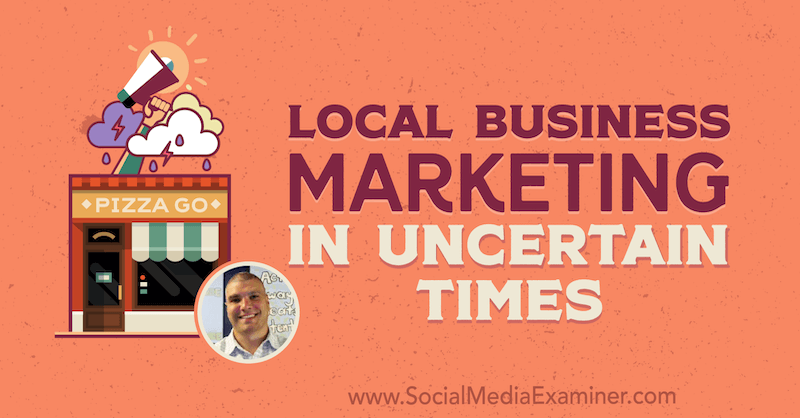
Note: This was recorded in the middle of April 2020, during the COVID-19 global pandemic—and we suspect some of the stay-at-home and social-distancing limitations will still be in place for a while.
The truth of the matter is that as of today, customers are afraid. Many of them don't want to visit any local businesses, especially those where people gather closely together. As marketers and business owners, it's up to us to stay top-of-mind and communicate with our customers throughout this time. Doing this ensures that they'll still be there for us when life returns to normal.
What to Do First
Bruce feels the first few things businesses have to do right now is not to bury their heads in the sand or focus on the negatives of the situation. Take a proactive approach. Show up every single day and reassure your customers that you're still around and that you're going to be around when this is over. Notify and educate them on whatever changes you're making in your business to adapt to the current circumstances.
Who knows how long this is going to last? And who knows what the “new normal” is going to look like when we do get out of this? A lot of local businesses out there are going to be completely different. Many businesses aren't ever going to be able to go back to the way they were before this happened. Start thinking about your plan for the future, and then talk to your customers about that plan moving forward.
Look at the systems you have in place in your business. You have time now. You may not be open and all of those little things—maybe that system you wanted to put in place or those photos or videos you really wanted to set up—can be implemented now while you have that extra time.
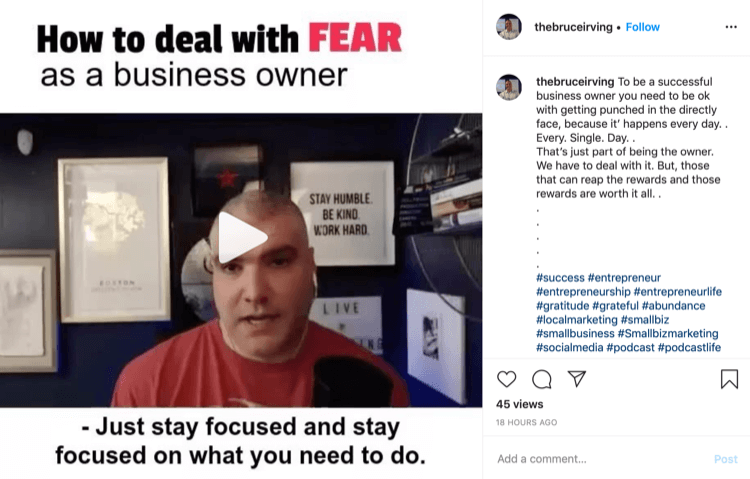
Customers have short attention spans. When you close down—if you're not showing up for them—they're going to forget about you when they resume their regular lives.
Get World-Class Marketing Training — All Year Long!
Are you facing doubt, uncertainty, or overwhelm? The Social Media Marketing Society can help.
Each month, you’ll receive training from trusted marketing experts, covering everything from AI to organic social marketing. When you join, you’ll also get immediate access to:
- A library of 100+ marketing trainings
- A community of like-minded marketers
- Monthly online community meetups
- Relevant news and trends updates
Creative Ways to Stay Top-of-Mind
Bruce says now is the time to double down on content. Don't be one of those companies that's afraid to market right now. Be on point with your message, show up consistently, and double down on your message on the platforms where you hang out. You don't want the next 6 weeks to go by without you showing up at all, and then all of a sudden, you reappear when everything's back open. You need to be consistently showing up every single day.
Think about a content marketing plan. To visualize this, you could start a podcast and take your expertise on the air. You could start writing articles for local publications in your community to provide some free value or perhaps you might start your own blog.
Bruce recommends coming up with some sort of daily or weekly show on Facebook, Instagram, or any other platform. Use the show to talk to your customers about what you're doing in your business, and to educate them. Be honest with them. Show them the processes and systems you're putting in place. When they're able to come back into your restaurant or business, they've seen you in the interim. You're still familiar and they haven't forgotten about you.
You don't necessarily have to go live but Bruce prefers live video over pre-recorded. When people record a video, they tend to overanalyze it and delete it a thousand times before they put it out. Done is better than perfect.
When you do something, you're going to stink at it in the beginning and you need to be okay with that. If you do it consistently over time, you will increasingly improve. When you do a live show, you just need to go and do it. There may not be many viewers. More people will come and they'll see that improvement.
Show people how you make your products and what you serve. Bruce noticed that Disney recently started releasing recipes for the products and snacks they serve at Disneyland such as churros, Dole Whips, and Tonga Toast. They released social media videos and recipe guides so you can recreate those classics in your own home since no one can go to Disney theme parks right now. Any restaurant can take that example and run with it.
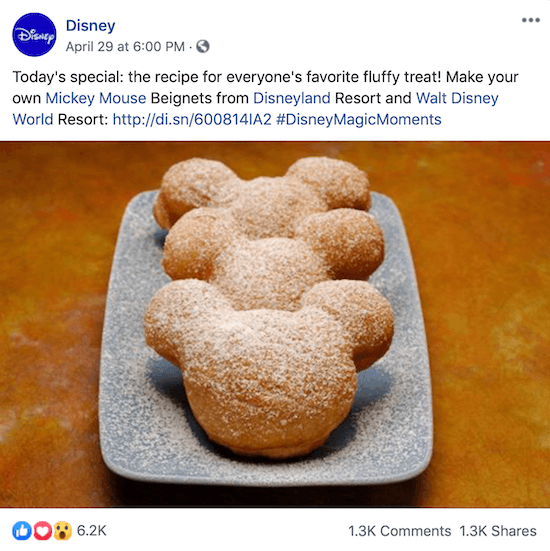
People are stuck in their homes, and as much as they may love cooking, they're getting sick of the same old recipes every single night. They want to know what else they can make. They want to know how they can make that restaurant's famous sandwiches at home. You can show a video of you doing that.
Or you can have a Tuesday-night online cooking class where people can learn something new that they can make with their families and enjoy. Then they're going to show up, they're going to try to recreate that recipe at home, and they're going to come back for the next one if they were successful.
To illustrate, Bruce's friend Mike owns the Tony Boloney's pizza chain in New Jersey. Mike started doing a cooking class live on Instagram every Sunday. He demonstrates how to make things like stromboli, fresh mozzarella, and pizza, and he sells kits to go along with whatever he's demonstrating.
All during the week leading up to his Sunday night live at 5:00 PM, Mike posts on social media about the kits people will need for that live video. People direct-message him and he sells them the product kits. Then every Sunday at 5:00 PM, he's going live showing the process of making that item. Mike does the videos from his house and he involves his two very young sons in the process, which is often funny and really helps to humanize him.
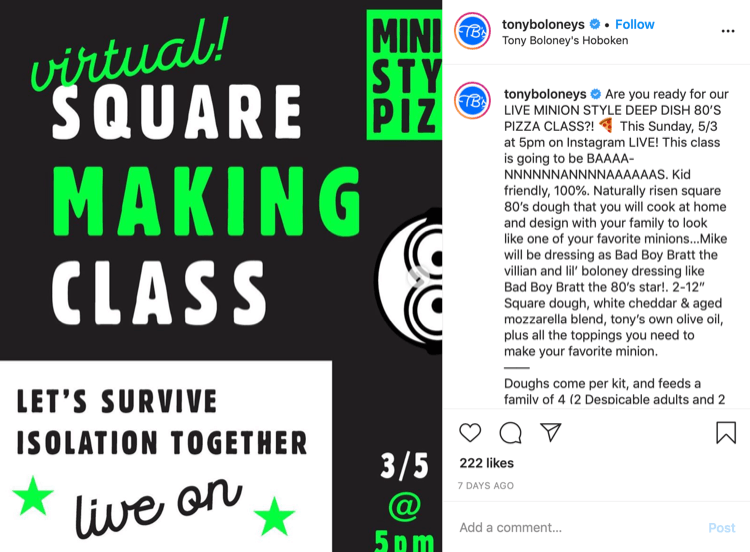
9Tailors is a suit and clothing tailoring shop that has pivoted recently to making protective masks. In many areas, if you go outside or to any public place, a mask is mandatory. 9Tailors is creating cloth masks for people to purchase that look cool and are designed really well.
They're making something different that they know is in high demand using the resources they already have at their disposal. That's not a business model that can be used long-term but it's a good quick pivot to keep that business going.
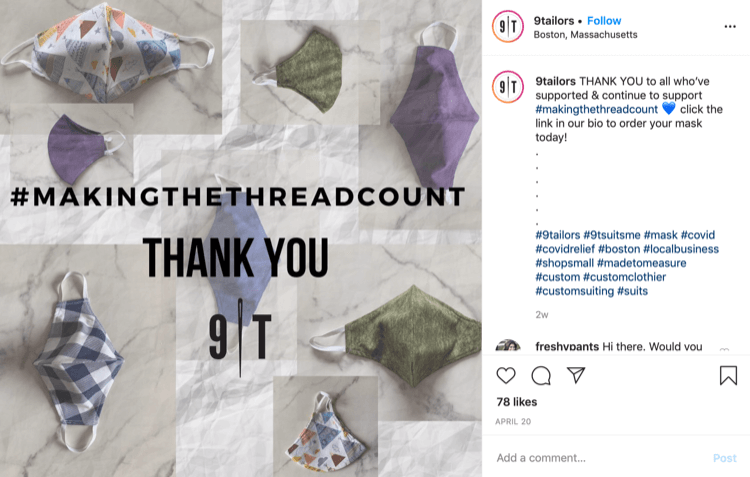
ZaRonis Pizzeria in Oshkosh, Wisconsin is a superhero-themed restaurant. For the last 5 months, even before this pandemic, they posted special offers in a private Facebook group for their community, almost like a VIP club. They also helped people out. If someone fell on hard times, ZaRonis supplied them with a meal. It turned into a huge group for the area, boasting nearly 7,000 members.
As soon as this whole catastrophe hit, that Facebook group completely supported this business and helped them out because ZaRonis had already been doing that for their community for the past 4 or 5 months. Now they're creating packages for people in need in the area, including little meal kits.
They're asking their distributors for additional items and packaging them together to donate to people who need food and help right now. The owner appeared on TV, which then led to monetary donations to help keep those kits coming. ZaRonis provided a service to the community in a Facebook group and the community decided to pay them back. It's amazing press and when ZaRonis opens back up, there are going to be a lot of happy, loyal customers coming in.
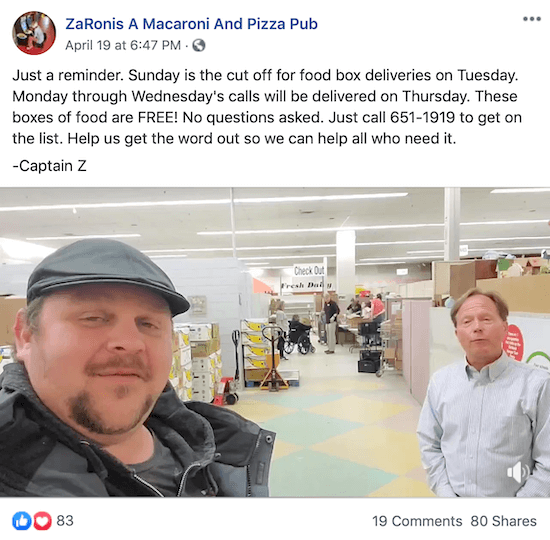
Roger Wakefield is a plumber in Texas. He shares everything on YouTube and LinkedIn, demonstrating things like what to do if your toilet gets clogged or how to fix the sewer pipes to your house. He's got around 30,000 subscribers on YouTube and he still gets local business as a plumber.
Bruce points out that in this industry, you want customers and you want employees. Likewise, Roger's YouTube videos not only get him customers from his local area, they also bring people to him who are interested in becoming plumbers. Roger has people asking him, “Hey Roger, can I work for you? Because I see your videos all the time and I want to learn how to be a plumber.”

Discover Proven Marketing Strategies and Tips
Want to go even deeper with your marketing? Check out the Social Media Marketing Podcast! Publishing weekly since 2012, the Social Media Marketing Podcast helps you navigate the constantly changing marketing jungle, with expert interviews from marketing pros.
But don’t let the name fool you. This show is about a lot more than just social media marketing. With over 600 episodes and millions of downloads each year, this show has been a trusted source for marketers for well over a decade.
He has the best of both worlds. He's getting customers and he's getting the hardest thing of all—employees who want to become plumbers.
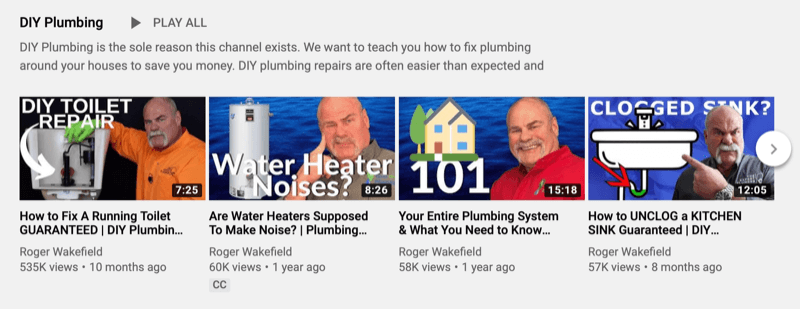
Staying in Touch via Email
What took most local businesses by surprise is that nobody could have anticipated a full stop. A lot of these businesses probably now wish they had email addresses so they could communicate more directly with their customers.
Bruce is a big advocate of email because social media platforms can change but your email list is the one thing you own. We've heard it all before but now it's more important than ever because no matter what happens on these other platforms, you can still communicate via email with your customers.
Bruce's clients are restaurant owners and they sell a lot through online ordering. When someone orders online, they have to enter their email address. Come up with some sort of strategy to incentivize your customers to give you their email. Give them a coupon code or a deal, have a special event, or do something that happens every time they order online from you. Come up with a good online-only deal so you can capture their email and communicate with them in the future.
Local businesses could go really far by taking a page out of the online business playbook. Bruce notes that a lot of online businesses offer free reports and eBooks. Similarly, you could put together a cooking guide or a video series in exchange for an email address. Another way of doing it is to offer an on-the-spot discount if customers are willing to give you their email address. Maybe you could even set up a frequent-diner program.
Digital copies of receipts are also a great way to get emails. A person who's taking credit card information over the phone, for instance, can ask for the customer's email address so they can send that digital receipt.
A lot of restaurants use Square as their point-of-sale system, which remembers customer information. Customers put their card in and Square recognizes them in the system and has all of their information saved. Square just emails them the receipt without them having to do anything. Most of these systems allow integrations with email management systems so you can either export or integrate it to send promotions or content.
Messenger bots are another great way to collect people's contact information. You can run ads—connected to a tool like ManyChat—that send out a discount. It could be sent to people who have connected with you on social, visited your website, or watched one of your videos. The ad is based on one of those actions.
You can create and send a message that says, “Hey, we saw that you were on this page looking at this item. Would you like a 10% discount? Just click this button or type a comment below to get the coupon code.” That triggers the bot to collect their email address, their phone number, and their name. Then it distributes the coupon through Facebook Messenger.
Diversifying Offerings and Delivery Methods
A lot of businesses, especially local businesses, are now wishing they had an online offering to turn to because they're so reliant on the physical location. Today, the drop in sales is motivated by COVID-19. Tomorrow, it could be because a big employer moves out of town and a bunch of jobs are lost or because a train terminal shuts down and there's not as much foot traffic. There are so many scenarios that can happen.
The good news—if there is any—is that if your business is closed, probably everybody else who sells similar products is closed, too. It's not like the guy across the street is open and thriving and you're closed. So here's your opportunity to do the thing that you've always wanted to do. If you've always wanted to transition your business to online, get going with it. There's an opportunity now to do that.
A lot of people don't understand how big online restaurant delivery is. It's huge. There are three billion-dollar companies—Uber Eats, DoorDash, and GrubHub. All they do is service online restaurant orders. They create ghost kitchens, get people to order using SEO from a website that they direct people to, then send the order off to the restaurant, and go pick it up. You can do all of that yourself.
You have to have the patience and time and put in the work, but all of that can be done on your own. Create a website, tell people that the website exists, and create content pushing people to that website. You can do all of that now. If you're closed, you have time to do that.
Some of these restaurants might not even have a physical walk-in location—they're just doing online orders. Bruce knows five restaurants that don't even have a location that you can pick up from or walk into—they're 100% digital ghost kitchens.
Bruce's friend Ric Gruber has a pizzeria in Chicago. He uses GrubHub and Uber Eats as a way to create new restaurants based out of his existing restaurant.
To visualize this, Ric went to GrubHub and Uber Eats and created a salad company. Why? Because he noticed that while he has great salads, his restaurant wasn't coming up in search on GrubHub for salads because they're labeled as a pizza restaurant. So he created Ric's Salads, and it's just a website where people can order his salads on GrubHub.
Happily, it comes up in the top three of local searches for salads. It emails him at his pizzeria as Ric's Salads but he makes them from Ric's Pizza. It's almost like a business within a business. He also does that to validate products. When he wants to test some products out, he'll do it on Ric's Salads because if Ric's Salads goes out of business, he doesn't really care.
Some food businesses want to expand beyond their local radius. Bruce realizes there's a big movement for frozen products now, especially in the restaurant space. People are trying to figure out how to create their items and freeze them for delivery. Businesses have the time to figure things like that out right now.
If you're a national company, you probably already have some sort of online platform. Domino's is one of the best digital companies out there; they just happen to serve pizza. Their pizzas aren't great—there's probably a hundred pizzerias in your area that are better than Domino's—and yet they sell more pizza than those others because they dominate digital.
They know what you're going to order because you've ordered from them before and they know what time you order, so they send you emails based on triggers from your past experiences there and they follow you online. They are a digital company that happens to sell pizza.
Encouraging People to Come Back In (When They Can)
Before the restrictions are even lifted, Bruce says to take a look at your business and how you're making money. If you're a business that's closed right now because you can't have customers come to you, look at your business model and figure out how you can prevent this from happening in the future.
Can you sell online? Can you sell courses or tutorial videos that you can monetize so you have multiple streams of income? When this is over, if there's a second wave of the virus or if something else happens, make sure you're not caught like you are now and completely closed with no revenue.
Different people are taking different levels of precaution so some people won't be ready to return to restaurants for a little while longer. Even when everything opens back up again, we'll probably avoid being around large crowds for another 6–12 months.
That 6- to 10-foot buffer zone between people is probably going to be the new normal for a long time. It'll be really important for businesses to use social media to convey the sanitizing precautions that they're taking to make sure that their physical business is safe for people to come into.
A lot of companies weren't quick to adapt. They thought their businesses would be fine and they didn't need to get their message out on Instagram. A lot of those businesses are really hurting. Nobody's calling to say, “Hey, can I ask you a couple of questions about your business? Are you wearing gloves? Do you have masks on? How do I order from you?” That's not what happens.
People go to Facebook, Instagram, or Twitter and look up these businesses to see what they're doing. Those businesses that were slow to adapt to social media are now scrambling to get on there and show the safety steps they're taking. The businesses that have been on social media for a while and already have that in place are the ones that people trust more right now.
Key Takeaways from This Episode:
- Find out more about Bruce on his website.
- Listen to The Local Business Podcast.
- Listen to the Smart Pizza Marketing Podcast.
- Watch exclusive content and original videos from Social Media Examiner on YouTube.
- Watch our weekly Social Media Marketing Talk Show on Fridays at 10 AM Pacific on YouTube.
Help Us Spread the Word! Please let your Twitter followers know about this podcast. Simply click here now to post a tweet.
If you enjoyed this episode of the Social Media Marketing podcast, please head over to iTunes, leave a rating, write a review, and subscribe. And if you listen on Stitcher, please click here to rate and review this show.
What do you think? What are your thoughts on how local businesses can market during uncertain times? Please share your comments below.
Attention Agency Owners, Brand Marketers, and Consultants

Introducing the Marketing Agency Show–our newest podcast designed to explore the struggles of agency marketers.
Join show host and agency owner, Brooke Sellas, as she interviews agency marketers and digs deep into their biggest challenges. Explore topics like navigating rough economic times, leveraging AI, service diversification, client acquisition, and much more.
Just pull up your favorite podcast app, search for Marketing Agency Show and start listening. Or click the button below for more information.

